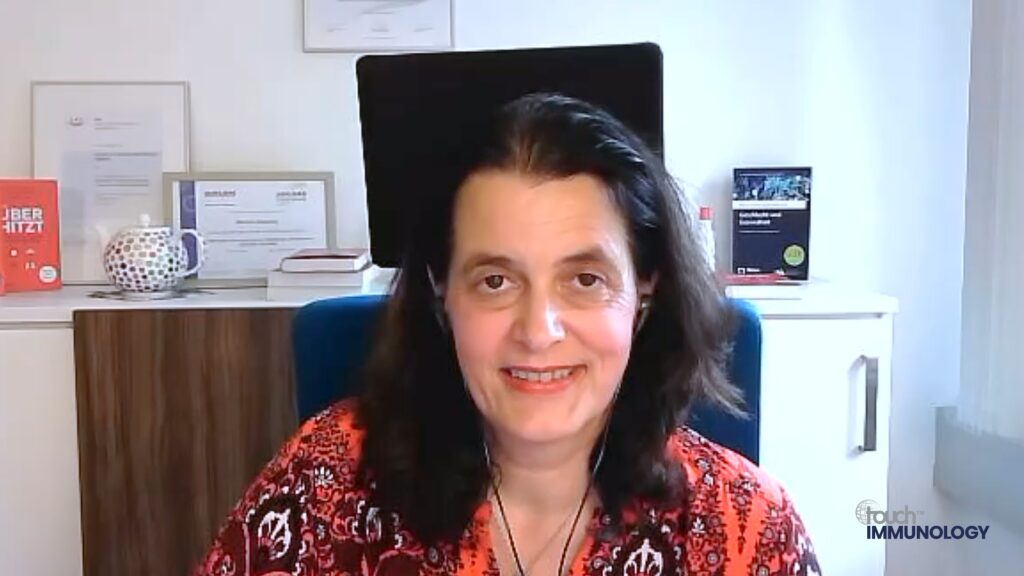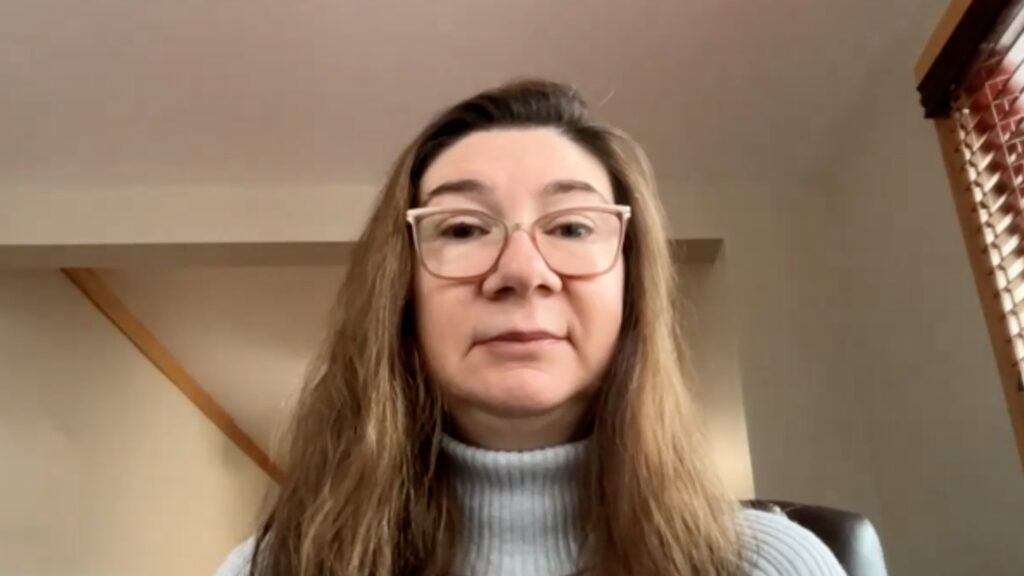Tezepelumab is a biologic drug for severe asthma that works by blocking thymic stromal lymphopoietin, a cytokine thought to be involved in airway inflammation. We caught up with Dr Warner Carr (Allergy & Asthma Associates of Southern California, A Medical Group; Southern California Research, Mission Viejo, CA, USA) to discuss the clinical utility of tezepelumab and key results from the NAVIGATOR study (NCT03347279), which shed light on how tezepelumab affects patient-reported rescue medication use and night-time awakenings in patients with severe, uncontrolled asthma.
The abstract ‘Effect Of Tezepelumab On Rescue Medication Use And Night-Time Awakenings In Patients With Severe, Uncontrolled Asthma: Results From The NAVIGATOR Study‘ (Abstract number: 046) was presented at AAAAI 2023, February 24–27, 2022, #AAAAI2023.
Questions
- What is tezepelumab and what is its mechanism of action? (0:29)
- What is already known about the clinical utility of tezepelumab in the treatment of severe, uncontrolled asthma? (2:50)
- What were the aims, eligibility and methodology of the NAVIGATOR study? (3:43)
- What were the main findings of the study, and how will these findings impact clinical practice? (5:49)
Disclosures: Warner Carr discloses the following: consultant and advisory board for AZ, Amgen; speaker’s bureau participant with AZ, Amgen.
Support: Interview and filming supported by Touch Medical Media Ltd. Interview conducted by Atiya Henry.
Filmed in coverage of the American Academy of Allergy Asthma & Immunology Annual Meeting 2023.
Transcript:
My name is Warner Carr. I’m an allergy and immunology doctor. I’m located here in Southern California. My practice is allergy asthma associates of Southern California. And I also have a clinical research center, Southern California Research. And we did some of the tezepelumab studies here at my research center.
What is tezepelumab and what is its mechanism of action? (0:29)
So tezepelumab is the scientific name for a branded product called Tezspire, tezepelumab is a monoclonal antibody. That means it’s an antibody that is exactly the same. It’s from one clone and it targets one very, very precise and specific target, a very tiny molecule that’s called TSLP and that stands for thymic stromal lymphopoietin. And this small molecule is released in the airway. Any time the airway is irritated, it’s both allergic and non-allergic triggers can cause the airway to become activated. We call it an alarmin and it signals downstream inflammation, downstream asthmatic inflammation, using both allergic and non-allergic mechanisms. And then within the tissue of the lung, there are several different cell types that once they’re stimulated, we’ll start making TSLP as well, propagating this inflammation. And these cell types are both structural cells as well as immune cells. So TSLP is kind of like a signal when there’s an injury from the outside to the airway and the airway has to communicate to the body down below. And in the setting of asthma, that causes all those classic traditional signs and symptoms of asthma, airway narrowing, airway inflammation and the resultant symptoms that our patients have: coughing, wheezing, shortness of breath, nighttime awakenings, decrease in their ability to work and do physical activity, and sometimes resulting in these patients seeking emergency medical care and ultimately ending up on oral corticosteroids, perhaps even hospitalization. And in 2023, there are still people dying from asthma. If you look at the hospitalization, reduction is over 80% with a medicine like tezepelumab, that’s a huge impact on those patients that are seeking emergency medical care and a huge impact on lowering the economic burden of asthma.
What is already known about the clinical utility of tezepelumab in the treatment of severe, uncontrolled asthma? (2:50)
Well, the clinical utility is good. Let me tell you, the future is bright for our patients, because if you look back 20 years ago when we first started having these biologics for asthma, they didn’t work. They didn’t work in all asthma patients, is what I should say. We had to kind of figure out different subtypes of asthma, if you will. And then we had targeted therapies for these different subtypes. Now we have tezepelumab and we have something that works in all of these different subtypes. So I would say the future is bright, we’re just getting started. And now we actually have something in our tool chest that treats all comers.
What were the aims, eligibility and methodology of the NAVIGATOR study? (3:43)
So the NAVIGATOR study, I think is a very important study. And those of us out there that treat severe asthma patients, if you’ve not read it, you should pull it up in the New England Journal of Medicine and read it. The NAVIGATOR study was a double blind, placebo controlled, randomized clinical trial that compared the efficacy, the effectiveness and the safety of tezepelumab in patients that had severe asthma to placebo. And we looked at a variety of different variables. And ultimately what we showed was that there was a significant improvement in the severity, well not severity, but the symptoms and significant reduction in exacerbations. In those patients that had a high allergy phenotype, you saw a reduction of over 70% in their exacerbations. What’s very important is when you see something that has such profound efficacy, you want to make sure that it isn’t coupled with significant safety concerns. And the good news is, tezepelumab being such a targeted therapy has been deemed to be very safe. And when you look at the package insert from the US FDA, you’ll see that there are very few adverse events. In fact, in the standard table there’s only three things listed. And these are typical things like pharyngitis and back pain, stuff like this that we see with pretty much any of these medications. So very safe. It’s effective. And most importantly, you know, patients feel better, their own lung function improves, their activity improves and they feel better. And that’s important for doctors like myself who are taking care of these patients. We just don’t want to see their numbers get better. We want to see our patients get better. So in these patients, asthma has been controlling their life. And we now have something that helps patients take the control back so they can do what they want in their lives.
What were the main findings of the study, and how will these findings impact clinical practice? (5:49)
Well, the primary endpoint in the study was the reduction in the annualized exacerbations. That was the primary efficacy and you saw a significant reduction in exacerbations compared to placebo. But like I said a moment ago, you know, in patients that have this allergic phenotype, that have both, you know, allergies, that type 2 inflammation high, there was over a 70% reduction in those exacerbations. The second and equally important finding was – so you have improvement in exacerbations as the primary endpoint and you see no real significant safety signal in these patients. That’s why it was approved and the clinical trial NAVIGATOR supported it. You know, there are some other secondary endpoints that were very, very important as well. These are things that I like to refer to as the asthma vital signs, if you will. Number one is the FEV1. This is the airflow in the large airway that improved significantly – that’s good. We also see things like your blood eosinophil count. This is a white blood cell that’s implicated in asthma, in the airway of asthma. The higher that number, the more severe the asthma is. Eosinophils went down. Airway inflammation, called the exhaled nitric oxide, that went down. IgE, which is immunoglobulin E or the allergic antibody, that went down. So you saw these biomarkers of asthma all go down and you saw airflow and air capacity go up. These are all secondary endpoints. And when you look at utilization of health care, you saw decreased urgent care visits, decreased hospital visits and decreased hospitalizations of over 80%. So those are all secondary endpoints that are also very, very important from the NAVIGATOR study.
Subtitles and transcript are autogenerated









